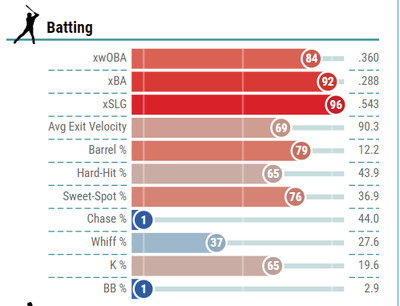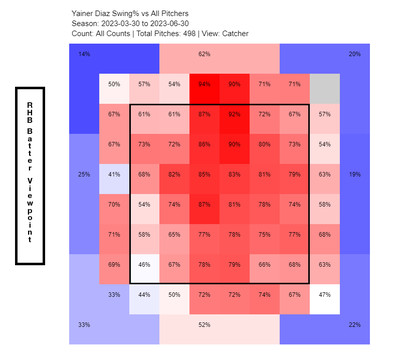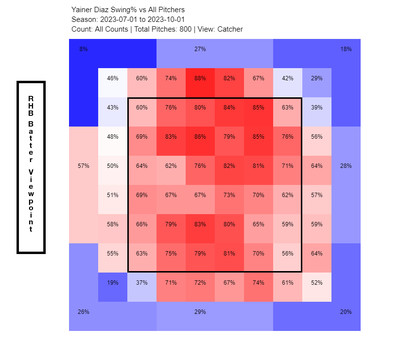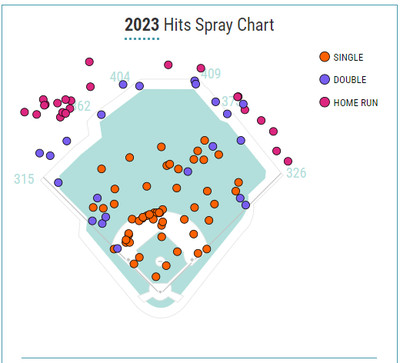
Yainer Diaz is a fast learner. Let’s hope he continues his growth trajectory in 2024.
Yainer Diaz teased us in 2023. It feels like he was too good to be true. I kept expecting him to regress. He never did.
I mean, why would a guy who had a 127 wRC+ only get 377 plate appearances? That was 40th in the league out of 245 players with 350+ PA’s. And on the rare occasions he got to play his natural position, catcher, his wRC+ was 170, the highest among catchers with at least 150 PA’s.
And this performance does not appear to be a fluke. Here’s a look at his Statcast expected numbers and barrel statistics.

As you can see, Diaz was elite in xwOBA, xBA and xSLG. He was well above average in all the contact numbers, and even in K%. Which is very strange because he is rock bottom in chasing bad pitches, below average in swing and miss, and he almost never works a walk.
And therein lies the reason for all the doubts and why only 377 PA’s. It just doesn’t seem like you can really believe in the long-term success of a batter who swings so wildly, so often, at so many bad pitches, even if he makes good contact with a surprising number of them.
But there’s hope above and beyond Diaz’s results in the small sample of 2023. The hope is in the improvement and adjustments he made throughout the year in overcoming his glaring weaknesses.
I looked at Diaz’s performance by dividing his season into three trimesters of approximately equal numbers of PA’s. There was a general improvement, not only in results but in plate discipline as well. And there was a marked change in his overall approach. It feels like he evolved within one season in the time most players develop in three.
First, let’s look at the results.
Diaz Result Stats

As you can see, Diaz’s BA and OBP improved in the third trimester. Slugging and wRC+ improved in both the second and third trimesters of the season. Although not shown, ISO improved each trimester as well. It should be noted that some of this latter overall improvement was aided by an improved BABIP: .329 in the third trimester, .279 and .269 in the first two.
Diaz Contact Stats

From this chart, we see that Diaz improved steadily in laying off pitches outside the zone, in reducing his swing rate in general, and in reducing his swinging strike rate. His BB% also improved somewhat. Although not shown here, the contact rate went down about one percent from the first trimester to the third.
In the following heat maps, we see that Diaz learned to lay off the high pitch to some extent as the season progressed. Here, I use only first half and second half of season comparisons.


Though both of these charts indicate a wild swinger, in the second-half chart, we see improved discipline, especially in the quadrants above the strike zone.
Oddly, while improving his outside-the-zone swing percentage, Diaz’s K% went up. However, this corresponded with an increase in slugging and ISO.
Another interesting aspect of the evolution of Diaz’s plate approach was his later tendency to hit to the opposite field. In the first two trimesters Diaz hit to right field about seventeen percent of the time. By the end of the season, that rate was 35.1%, almost as high as his pull rate of 41.5%.
It seems that Diaz took a more conservative approach as the season progressed, swinging less, and going to the opposite field. I can’t confidently explain why this led to more strikeouts, but I’ll surmise that it had something to do with adjusting to this new approach.
But hitting to the opposite field didn’t affect Diaz’s power numbers. As we saw, his SLG increased as he hit more to right, and he hit nine of his 23 home runs in the third trimester of the season. However, the average EV went down from about 91 in the first two trimesters to about 90 in the third.
One of the aspects of Diaz’s performance that encourages me about his future is his ability to hit and hit with power to all fields. Here is his spray chart.

Overall, Diaz came into the 2023 season as a very raw talent. He seems to have spent the year trying to find a sustainable big-league approach. The fact that he continued to produce while still trying to find his way, and remaining successful while experimenting with different approaches throughout the year, speaks well for his future. Diaz is still immature; he has well-known and exploitable weaknesses at the plate, and yet he still succeeds.
The three main takeaways from Diaz’s first season are:
- Despite terrible plate discipline, Diaz somehow maintains decent contact rates and big-time power. It reminds me of an early Altuve except Altuve started out as a spray hitter
- Diaz learns fast.
- Watch out when Diaz finally finds the approach that works best for him.
Seeing Yainer Diaz’s continued progress is perhaps the one thing I look forward to the most in the coming 2024 season.